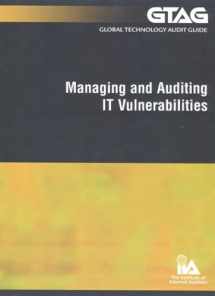
Global Technology Audit Guide 6: Managing and Auditing It Vulnerabilities
ISBN-13:
9780894135972
ISBN-10:
089413597X
Author:
Sasha Romanosky
Publication date:
2006
Publisher:
Institute of Internal Auditors, Inc.
Format:
Paperback
18 pages
FREE US shipping
Book details
ISBN-13:
9780894135972
ISBN-10:
089413597X
Author:
Sasha Romanosky
Publication date:
2006
Publisher:
Institute of Internal Auditors, Inc.
Format:
Paperback
18 pages
Summary
Global Technology Audit Guide 6: Managing and Auditing It Vulnerabilities (ISBN-13: 9780894135972 and ISBN-10: 089413597X), written by authors
Sasha Romanosky, was published by Institute of Internal Auditors, Inc. in 2006.
With an overall rating of 3.9 stars, it's a notable title among other
books. You can easily purchase or rent Global Technology Audit Guide 6: Managing and Auditing It Vulnerabilities (Paperback) from BooksRun,
along with many other new and used
books
and textbooks.
And, if you're looking to sell your copy, our current buyback offer is $0.47.
Description
Vulnerability management is a set of processes and technologies that an organization employs to identify, assess, and mitigate business risks arising from the deployment and use of IT assets and processes. But it is not just an IT issue. Vulnerabilities translate into real business risks if the right management approach is not taken.Throughout the vulnerability management process, the role of internal auditors is to assess the effectiveness of preventive, detective, and mitigation measures against past and future attacks. In addition, auditors need to inform the board of directors of the threats, vulnerabilities, and corrective measures taken to fix problem areas. In particular, auditors identify where IT security can implement more effective vulnerability management processes and better validate existing vulnerability remediation efforts.This 24-page guide was developed to help CAEs and internal auditors ask the right questions of IT security staff when assessing the effectiveness of their vulnerability management processes. The guide recommends specific management practices to help an organization achieve and sustain higher levels of effectiveness and efficiency and illustrates the differences between high- and low-performing vulnerability management efforts. After reading this guide, you will: Have a working knowledge of vulnerability management processes. Have the ability to differentiate between high- and low-performing vulnerability management organizations. Be familiar with the typical progression of capability from a technology-based approach to a risk-based approach to an IT process-based approach. Provide useful guidance to IT management on best practices for vulnerability management. Be able to sell your recommendations more effectively to your chief information officer, chief information security officer, chief executive officer, and chief financial officer.The guide also provides example metrics to use when measuring vulnerability management practices, such as identifying the number of unique vulnerabilities, the percent of total systems that are subject to a configuration management process, and the mean time to remediate a problem. Finally, the guide lists the top 10 questions CAEs and internal auditors should ask about vulnerability management and illustrates answers indicative of low- and high-performing organizations.This document is also available in PDF format.>br


We would LOVE it if you could help us and other readers by reviewing the book
Book review

Congratulations! We have received your book review.
{user}
{createdAt}
by {truncated_author}


